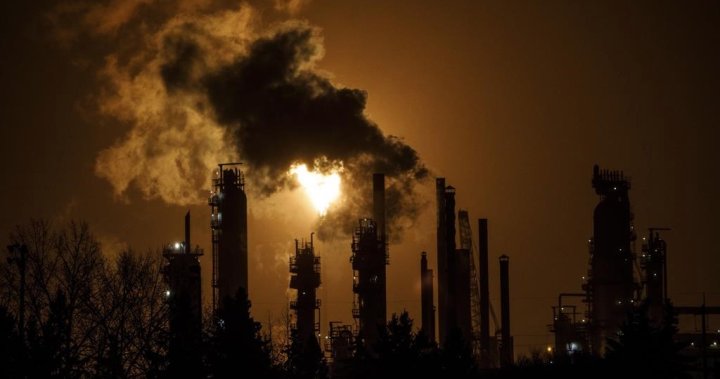As large swathes of the Western U.S. and central Canada continue to grapple with blistering heat, several climate and environmental safety experts are calling on governments and communities on all levels to double down on mitigation and adaption efforts to the inevitable effects of climate change.
Dozens of heat records were broken during the heat dome’s initial bombardment in Western Canada in late June, with over 60 records set on a single day alone in B.C.
The small British Columbian community of Lytton, which suffered from a catastrophic wildfire last week, set Canada’s hottest temperature record several times during the heatwave — up to a blistering 49.6 C.
Read more:
Group of scientists concludes climate change made B.C., Alberta heat wave 150 times more likely
BC Coroners Service recorded upwards of 700 deaths over the week during B.C.’s heat wave — three times as much as what would be normal during that period.
Now, as the heat wave passes through central Canada — baking parts of Manitoba, Saskatchewan and Alberta — as well as setting forests ablaze in the U.S.’s Pacific Northwest, climate scientists are saying that the time is now for much more aggressive action to protect against such extreme weather events.
Ian Mauro, the executive director of the Prairie Climate Centre at the University of Winnipeg, said that extreme weather events like the Western Canada heat wave could potentially be happening every five to 10 years once global warming passes a certain threshold that’s expected to be surpassed in the 2040s.

Scientists have suggested that the most recent heat wave was an event that happens once every 1,000 years.
“We’ve been saying this for a number of years, climate scientists have been saying it for decades,” said Mauro.
“Now we are in the era where our projections about the future are playing out in real-time, and the extreme heat that Canada has faced this year is an indication of climate change happening in real-time, impacting real communities and environments.”
William Cheung, a professor at UBC and director of its Institute for Oceans and Fisheries, said that while we can’t predict when these extreme weather events will occur in the future, there is widespread certainty that they will eventually happen again — in increasing frequency and intensity.
Read more:
60 historic temperature records smashed in B.C. Sunday as ‘dangerous’ heat wave continues
He cited a recent analysis from a group of international scientists from Canada and abroad that argued that climate change made Western Canada’s heat wave 150 times more likely.
“I think what this means is that more generally and more broadly, we need to do good climate mitigation because we are pumping more carbon dioxide and it would just increase because of the intensity of these kind of events,” said Cheung.

According to Mauro, even though Canada and other areas with geographies more susceptible to the effects of climate change are now beginning to see the outcome of years of human pollution and greenhouse gas emissions, now would be the “perfect moment” for governments, industry and the community to support what’s needed to get a handle on the rapidly changing climate.
He said that efforts to mitigate climate change, like reducing emissions, would need to be coupled with a “robust, systematic and well-resourced” adaption strategy.
How Canada’s communities and cities choose to adapt would differ greatly between them and their geographic and social situations, but Mauro listed a few examples.
Northern remote communities that rely on diesel to power their electrical grids could consider using more self-reliant energy sources, while “hydro-rich” British Columbia could have more renewable energy powering their grids.

A 734-page report from Natural Resources Canada, released during the week of Western Canada’s heatwave, found that shifting rainfall patterns and rising temperatures and sea levels will continue to “persist, and in many cases, will intensify over the coming decades.”
The report said that the impending change in weather patterns could strongly affect all aspects of life, from food security to trade to immigration, and warned that Canada’s lack of preparedness for these patterns could be disastrous.
The report emphasized adaption, in particular concerning Canada’s infrastructure — with everything from roads to sewers and hydro lines being at risk. Canada for the most part, the report said, was originally designed for a northern climate, and not built to weather a rapidly-changing one.
Read more:
Report warns of ‘large gaps’ in Canada’s preparedness for climate change disasters
“It’s first understanding that nuanced nature of the country and how climate change affects different jurisdictions in different kinds of ways,” said Mauro.
Ryan Mackie from BCIT’s Centre for Ecocities said that cities and communities were going to have to take a look at their vulnerabilities and address those specifically.
To counter blistering hot temperatures, as an example, Mackie encouraged more widespread use of “passive buildings,” which could lower the demand for power to regulate temperatures indoors to stay cool in the summer or keep warm in the winter.

Mackie said we can start designing Canadian cities to regulate more heat by planting more urban forests to create shading in places that are hotter or, in the case of more intense precipitation, using more permeable surfaces in buildings and restoring wetlands to soak up the excess water.
“We want to kind of mimic what’s normally done in nature as well,” he said.
Read more:
What is it like to live in the hottest place in Canada?
Lastly, Mackie said that the biggest vulnerability we have to adapt to concerns food security, and how fast-changing extreme weather events not only in Canada but overseas, where much of the country’s food is imported from, can affect food supplies.
“We’re seeing a number of that this year — inadequate water or too hot or too cold at different times in the spring — and so our agricultural industry really needs to invest in ways to mitigate their vulnerability with increased irrigation and shading and different practices to be able to adapt to handle extreme weather events,” Mackie said.
While there are many aspects of Canadian industry and infrastructure that could potentially be changed or adapted to the changing climate, several experts pointed at one that can not be ignored — the vulnerable people who would have to weather such extreme events.

“We have different kinds of people in different kinds of contexts with different kinds of capacities that need to be seriously thought of,” said Mauro. “What we know is that extreme heat causes social vulnerability to certain people in society over others.”
He pointed to seniors as having been “pummeled” by the last heatwave, many of which may have been isolated or have underlying health conditions. New infrastructure, like splash pads — as well as urban canopies — would go a long way in helping “cool the system” and reducing the risk to those who were most vulnerable.
“When we think about climate change and we think about these heatwaves, this is like the beginning days of the pandemic, and we need to rapidly change our behaviour and we need governments and policy and industry and communities to support that rapid behavioural change,” Mauro said.
“And we now know we can do it. And so to me, we’re living in a perfect moment.”
© 2021 Global News, a division of Corus Entertainment Inc.
















































